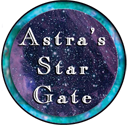Astra's Featured Biographies of Extraordinary Women
Welcome to the Astra's gallery of biographies representing Starwimin and others with important biographies and interesting stories. Usually at least one link to a site with reliable information will be given so that a more in-depth study of an individual may be undertaken. Many of the biographies here could rate their own page - - but until they are posted, enjoy these.
Women's biographies on this page:
Lindy Elkins-Tanton - Grace Hopper - Nancy Grace Roman - Catherine Wolfe Bruce
Grace Hopper
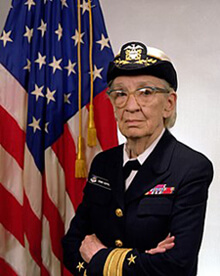
Born in New York City in December 1906, Grace Hopper had three siblings. Her parents were Walter Murray and Mary Van Horne. Grace was admitted to Vassar College at age 17, continuing her education until she earned a Ph.D. in mathematics from Yale University in 1934. She was married to Vincent Hopper in 1930 but was divorced in 1945. She taught mathematics at Vassar College from 1931 to 1943 when she joined the Navy Reserves during World War II. She trained at the Naval Reserve Midshipmen's School at Smith College and graduated first in her class. In 1944, she was assigned o Harvard University where she worked on the Mark I computer programming staff.
An early computer pioneer, Grace was hired at Eckert-Mauchly Computer Corporation where she helped develop the UNIVAC computer as a senior mathematician. Holding to her belief that a programming language could be based on words, she developed the first operational compiler. In 1967, she was recalled by the Navy where she rose in rank and served until 1986. Due to wide range of Rear Admiral Hopper's accomplishments as a pioneering computer scientist and her naval rank, she is sometimes referred to as " Amazing Grace".
The " Grace Hopper Celebration of Women In Computing Conference " is an annual technical conference that encourages women to enter the field of computing, and the Association for Computing Machinery (ACM) offers the "Grace Murray Hopper Award" to women (age 35+) who have made outstanding contributions in the computer science field.
USS Hopper (DDG-70)
The United States Navy Arleigh Burke-class guided-missile destroyer is named for the pioneering computer scientist Rear Admiral Grace Hopper. The ship was built in Bath, Maine, and was christened in January 1996.

Nancy Grace Roman
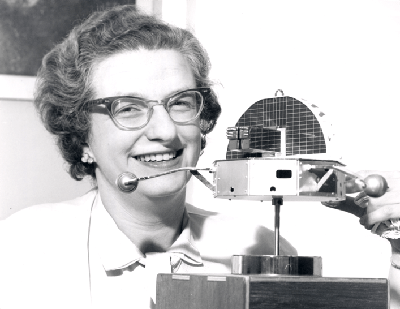
Born in Nashville, Tennessee, on May 16, 1925, Nancy Grace Roman was an only child. Her father was Irwin Roman, a geophysicist and her mother, Georgia Smith was a piano teacher. The family moved often because of the oil company Irwin worked for so Nancy lived in four states before she was three.
Nancy earned a bachelor’s degree in astronomy from Swarthmore in 1946 and a doctorate from the University of Chicago in 1949. She worked at Yerkes Observatory for six years, while there she observed the star AG Draconis and discovered that its emission spectrum had changed from earlier observations. This discovery helped to increase Nancy's status as an astronomer. AG Draconis is a double star, a red giant with a white dwarf companion.
In 1954, she took a position at the U.S. Naval Research Laboratory and worked in radio astronomy. She became the head of the microwave spectroscopy section of the radio astronomy program. She was consulted many times, including work on the Vanguard satellite program, her first experience with the NASA space program.
Known sometimes as the "Mother of Hubble" , Nancy Grace Roman was hired by NASA in 1959 to help set up the Office of Space Science. In 1960, she was made the Chief of Astronomy, the first woman to hold an executive position at NASA. Nancy was instrumental in developing the agency’s many space telescopes.
The picture here shows Nancy with a model of the Orbiting Solar Observatory (OSO). Nancy was in charge of the OSO program. It consisted of 8 satellites, the first one successfully launched in February 1962 and was designated OSO-2.
Other astronomical satellites that Nancy Roman oversaw reads like a list of who's who of orbital astronomical observatories. Among these include the Small Astronomy Satellite series: SAS-1,the X-ray explorer Uhuru; SAS-2, a gamma ray observatory that discovered Geminga an interest gamma source; SAS-3, an X-ray telescope named Copernicus. She was involved with Infrared Astronomy Satellite (IRAS), Cosmic Background Explorer (COBE), International Ultraviolet Explorer (IUE). She was also involved with astronomical experiments on Spacelab, Gemini, Apollo, and Skylab. Nancy also led NASA’s airborne astronomy program, putting telescopes on airplanes. This enabled NASA to fly a 12-inch telescope on a Learjet and a 36-inch telescope for the Kuiper Airborne Observatory. She even helped to put astronomical experiments on balloons.
Perhaps the most important telescope Nancy helped to launch into in orbit was the Hubble Space Telescope. Nancy gave public lectures about the scientific value of such a facility. In 1971, Nancy set up the Science Steering Group for the Large Space Telescope, and appointed NASA engineers and other astronomers to the group. They were to design a useful orbiting space telescope observatory that was possible for NASA to build.
Retiring in 1979 to care for her ailing mother, Nancy finished work on the telescope program to complete the contract selection process. Nancy was interested in computer programming because she thought she could continue the research she left behind as a young woman. She audited a course at Montgomery College and started to work as a consultant for Old Republic International Corporation (ORI), a government contractor. Eventually she went to NASA’s Goddard Space Flight Center and began working in the Astronomical Data Center. In 1997 Nancy left contract work at NASA and began teaching advanced junior high and high school students and K-12 science teachers as well as those in under-served districts. For ten years she recorded astronomical textbooks for Reading for the Blind and Dyslexic.
Nancy Grace Roman Telescope
NASA renamed the Wide Field Infrared Survey Telescope (WFIRST) in honor of Nancy Grace Roman in May of 2020. It will be an orbiting observatory designed to work on dark energy and exoplanets. The primary mirror is to be 7.9 feet (2.4m) in diameter. Two instruments are planned: A Wide Field Instrument and a complex stellar Coronagraph to study nearby exoplanets.
Nancy's autobiography is a superb reference also a source for this biography:
Nancy Grace Roman and the Dawn of Space Astronomy - Annual Review of Astronomy and Astrophysics Vol. 57:1-34 (August 2019)

Lindy Elkins-Tanton
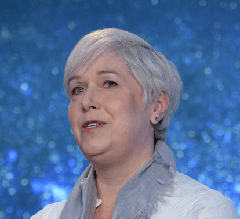
She was born in Ithaca, New York in 1966. A rocky childhood didn't stop her from pursuing a career in science. She has encouraged others and in fact is a cofounder of Beagle Learning. Beagle Learning helps teams learn faster as they work. Beagle Learning provides a process to gather input from the team and select the most important questions to focus on. They use an AI system to measure the quality of the questions teams choose, and automatically record the logic behind decisions made to avoid repeated work.
Dr. Elkins-Tanton earned her B.S. in geology, M.S. in geochemistry, and Ph.D. in geology, from the Massachusetts Institute of Technology (MIT) in Cambridge, MA. She also was an associate professor at MIT until becoming the director of the department of Terrestrial Magnetism at Carnegie Institution for Science. In July 2014, Dr. Elkins-Tanton became the director of the School of Earth and Space Science at Arizona State University (ASU). While at ASU she created the ASU Interplanetary Initiative working with ASU President, Michael Crow. The Interplanetary Initiative is working toward the future of humans in space while building a bolder and better society on Earth. It encourages a diverse group of individuals while building a new model for integrated research, and communicating positive human interplanetary futures. The initiative works to connect the private sector, universities, and government for bolder futures in space and better societies on Earth.
Dr. Elkins-Tanton is the author or co-author on many peer reviewed papers. In addition, she has edited many books on volcanism, global environment change, and planetary science. She worked on the team that confirmed that the Siberian flood basalts caused the extinction at the end of the Permian. She recently (2022) published her memoirs, "Portrait of the Scientist as a Young Woman".
Asteroid (8252) Elkins-Tanton
Discovered on March 1, 1981 by S. J. Bus at Siding Spring Observatory under the U.K. Schmidt-Caltech Asteroid Survey . The asteroid was renamed 8252 Elkins-Tanton in honor of Dr. Elkins-Tanton.
Elkins-Tanton is the Principal Investigator of NASA's Psyche mission to explore the metallic asteroid 16 Psyche.

Catherine Wolfe Bruce

One of the most prestigious awards that can be given to an astronomer is the Astronomical Society of the Pacific’s Bruce Medal. The medal was established in 1897 by Catherine Wolfe Bruce, a benefactor for astronomical causes who was well known in her day. Little is known about Catherine who was born January 22, 1816 to George Bruce and Catherine Wolfe. George Bruce was a type designer and producer of typefaces. He and his brother, David, opened the Bruce Foundry in New York City in 1806 becoming very wealthy beginning with their new method of dry press printing.
Details about Catherine come from her obituaries, even the picture posted here (downloaded from the Wikipedia Creative Commons and restored by Astra) has been called into question as to the true identity. A portrait of Catherine is also in question, this could even be her mother who had the same name. There is more to know about Catherine by using some of the available data and considering the times of her life. Catherine's parents married in 1811, Catherine had an older sister Jenet and was about 2 years old when her sister Eliza was born. Unfortunately she died at the age of two and Catherine's parents had another daughter named Eliza born a year later. Eliza lived until the age of 7, presumably these deaths affected Catherine deeply. Her brother David was born when Catherine was 8, a younger sister Matilda born when she was 10, and her youngest brother, George, was born two years later. So Catherine had six siblings and as she was growing up, presumably her family's wealth grew steadily. Her family life obviously revolved around the printing world. She often quoted Isaiah Thomas saying, "Printing is the perservative of all arts."
There is no mention of where she might have studied, but is reported to have learned of Edward Pickering's request for funds to build a telescope at the Harvard observatory in an Alvan Clark brochure.
Catherine Wolfe Bruce was an accomplished painter. She spoke Latin, Italian, French and German and also studied the arts in those languages. In 1890, she wrote a translation of Dies Irae (Day of Wrath). In memory of her father, Catherine founded the George Bruce Free Library. She obviously had a love of printing and of books, and may have been an amateur astronomer herself. She is known to the world as a patroness of astronomy--having donated funds to Harvard Observatory, Yerkes Observatory and many small donations to help astronomers. She donated $10,000 to Max Wolf for the Bruce Double Astrograph, telescope to be installed at Landessternwarte Heidelberg-Königstuhl, the Heidelberg observatory.
Max Wolf had his own double-astrograph telescope, a double telescope with two 6-inch refractors that he used to take photographs. Astrograph telescopes are essentially camera. It seems likely that Wolf's telescope was a model for the Bruce telescope, two 16-inch or 41cm refractors. The Bruce Double Astrograph saw first light in 1900.Today the Bruce telescope is used for public outreach programs.
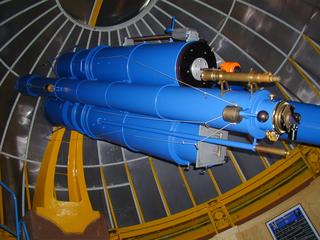
Max Wolf began finding asteroids on his 6-inch double astrograph and was one of the first astronomers to use photographic plates to find asteroids. On December 22, 1891, Max Wolfe discovered his first asteroid and named it 323 Brucia, after Catherine Wolfe Bruce. Wolf went on to discover 228 asteroids photographically. In addition, over 800 asteroids were found by Max Wolf and other asteronomers using the 2 double astro-graph instruments. Catherine actually taught classes at Heidelberg, as an unpaid volunteer.
Some Resources for Catherine Wolfe Bruce
A Brief History of the Bruce Medal of the A. S. P.
The Astronomical Society of the Pacific journal, Mercury, Vol. XV, Number 4, contained a write up of the Bruce medal. It contains some biographical information and the list of Bruce medal winners through 1985.
Catherine Wolfe Bruce - Linda Hall Library Scientist of the Day
The Glass Universe, Dava Sobel (2016)

Stay tuned for more short biographical stories at Astra's Stargate!
Please feel free to point others to this URL. Images on this page are in the public domain in the U.S.A. The text on this page is copyrighted, ©2020, and 2022 by the author, Dawn Jenkins, and is NOT released into the public domain. It should not be copied to another site without permission or otherwise published without contacting and crediting the author, Please read the copyright statement linked below. For more information and other permissions use Astra's Contact Page

